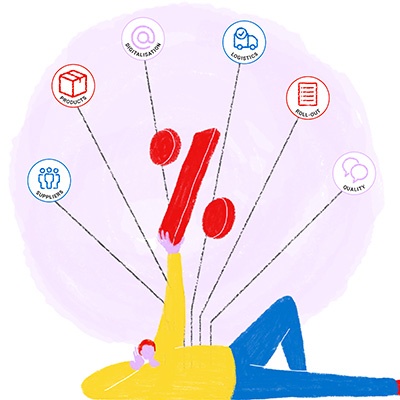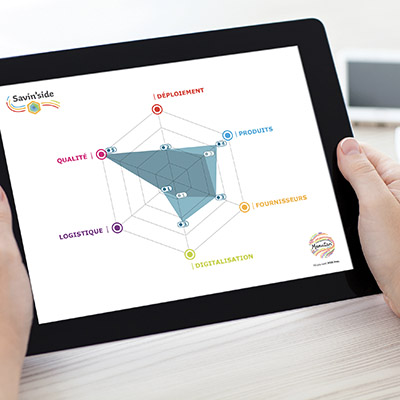In today’s business environment, the ability to adapt and continually improve processes is essential for staying competitive. Continuous improvement is a systematic approach aimed at identifying and eliminating inefficiencies, enhancing product and service quality, and optimising operational processes. Discover in this article the tools and methodologies that will help you integrate continuous improvement into your company, thereby boosting your process efficiency, enhancing customer and employee satisfaction, and increasing overall performance.
What is continuous improvement?
Continuous improvement is a fundamental pillar for any organisation wishing to remain competitive and innovative. It encompasses various methods and tools, each with its specificities and advantages. To fully understand the impact and application of continuous improvement, it is essential to explore its definition, origins, and the different approaches that comprise it.
Definition
Continuous improvement is a methodical strategy that aims to constantly enhance an organisation’s processes, products, and services. Unlike one-off initiatives, it is part of a dynamic of constant progress involving employee engagement and using specific improvement techniques to identify the root cause of problems and correct inefficiencies. It mobilises several methodologies that work in synergy. Continuous improvement helps companies to gain performance and durably improve their competitiveness.
The Kaizen approach
Originating in post-war Japan, the Kaizen method, which means "change for the better" in Japanese, is a continuous improvement model that focuses on gradual and regular small changes involving all levels of the organisation. It is based on the idea that daily incremental improvements can have a significant long-term impact.
The Deming Wheel (PDCA)
Derived from the work of William Edwards Deming, the Deming Wheel or PDCA cycle (Plan Do Check Act) is a structured method for testing and implementing improvements. The steps of the PDCA cycle are as follows:
- Plan: Identify a problem and develop a solution.
- Do: Implement the change on a small scale to test its effectiveness.
- Check: Verify the implementation results and analyse the data to see if the improvement efforts worked.
- Act: If the solution is effective, implement it on a larger scale and standardise the change. Otherwise, repeat the improvement cycle and develop a new plan.
The Six Sigma method
Six Sigma is a quality management methodology aimed at reducing process variations and eliminating defects. It uses statistical tools and project management techniques to identify the root causes of problems and systematically resolve them.
Lean Management
Lean Management is a management concept aimed at maximising customer-added value while eliminating waste. This Lean methodology, originally developed by Toyota, is based on identifying and getting rid of non-value-adding activities in production processes. The application of Lean Management offers the following benefits:
- Improving operational efficiency;
- Reducing costs;
- Increasing customer satisfaction.
Process analysis
Process analysis is a key step that supports continuous improvement. It involves examining existing processes in detail to identify inefficiencies and improvement opportunities.
Several tools can be used for this purpose, such as:
- Flowcharts;
- Value Stream Mapping (VSM);
- Ishikawa diagrams (or cause and effect diagrams).
These tools enable companies to visualise the steps of a process and identify bottlenecks. It then offers solutions to optimise workflows.
How to implement a continuous improvement approach?
To effectively integrate continuous improvement into your organisation, it is necessary to follow a structured and methodical approach. It features several keys steps: Defining specific objectives, identifying processes that need to be improved, involving teams and managers, and monitoring the results. Here are the four stages to successfully implement continuous improvement.
Step 1: Defining objectives
To start a continuous improvement approach, the first stage is to define clear and achievable objectives. SMART (Specific Measurable Achievable Relevant Time-bound) objectives are particularly effective in this context.
Step 2: Identifying processes to improve
Once the objectives are defined, it is necessary to identify the key processes that require improvements through a root cause analysis. This can be done using methods such as SWOT analysis (Strengths Weaknesses Opportunities Threats). It helps to evaluate internal strengths and weaknesses, as well as external opportunities and threats, providing an overview of areas needing intervention.
Step 3: Involving teams
The involvement of teams and stakeholders is essential for the success of continuous improvement. Employees are often in the best position to identify inefficiencies and offer practical solutions and feedback. This can also create a culture of continuous improvement within the company, leading to a beneficial transformation in the long term.
Step 4: Monitoring and measuring results
The final step is to monitor and measure the results of improvement initiatives. This can be achieved using Key Performance Indicators (KPIs) and dashboards. KPIs quantify progress towards set objectives, while dashboards offer a clear and concise view of performance.
What are the benefits of continuous improvement?
Adopting a continuous improvement approach offers many benefits for companies. In addition to improving product and service quality, it also optimises operational efficiency and strengthens team and customer satisfaction.
Improvement of quality
Continuous improvement can have a direct and significant impact on product and service quality. By adopting a systematic approach to identify and eliminate inefficiencies, companies are able to offer a more reliable and consistent product to their customers.
Increased operational efficiency
Continuous improvement optimises operational processes, leading to increased efficiency. By eliminating waste and streamlining operations, companies can produce more and better with fewer resources.
Satisfaction of employees and customers
Implementing continuous improvement also positively impacts employee well-being and customer satisfaction. Employees feel more engaged and valued when they actively participate in process improvement, which can reduce turnover and increase productivity.
In conclusion, continuous improvement is an essential change management approach for any company wishing to remain competitive and efficient in the current economic context. This approach is based on solid principles that enable organisations to:
- Optimise product and service quality;
- Gain operational efficiency;
- Strengthen employee and customer satisfaction.
It also offers practical ways to implement these principles and achieve tangible results.









